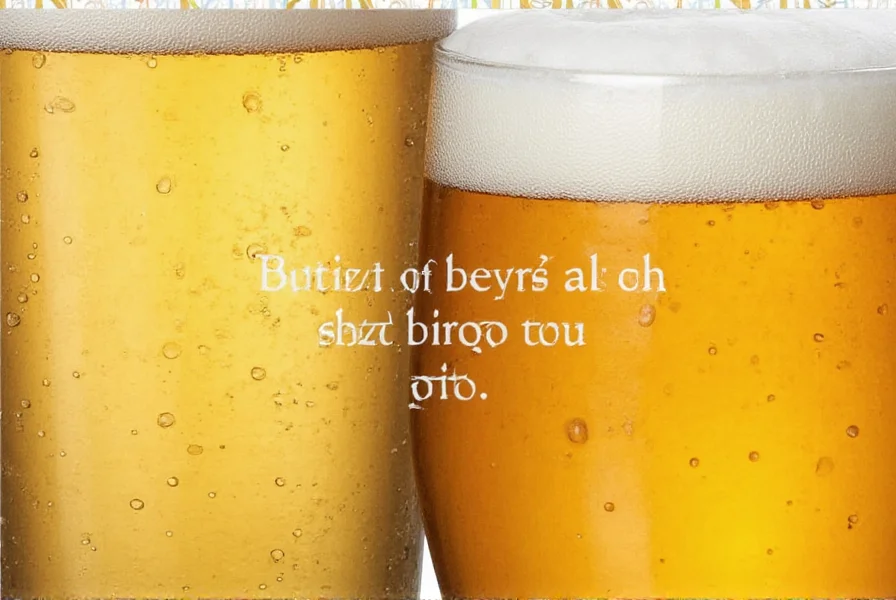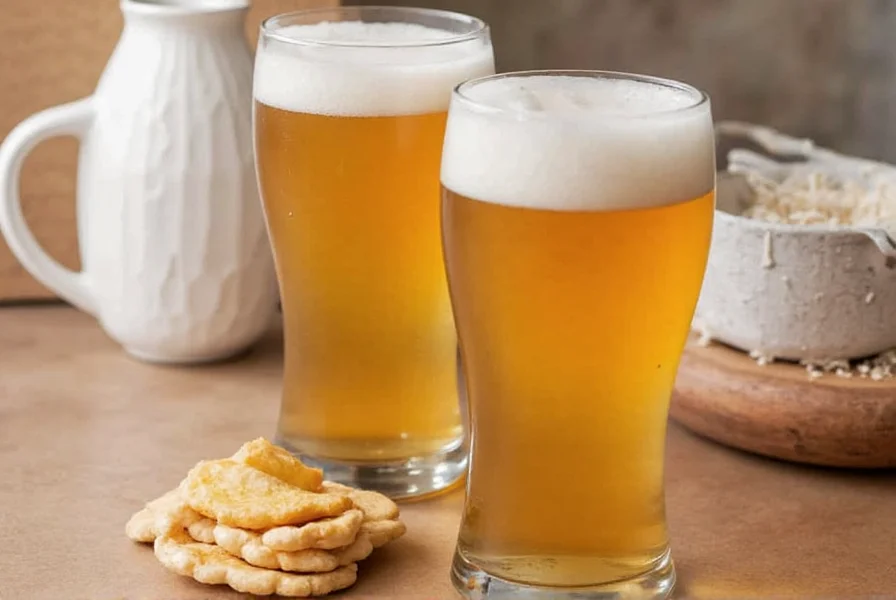Many people confuse ginger beer and ale due to similar-sounding names and historical connections, but these beverages belong to entirely different categories. Understanding their distinctions helps consumers make informed choices whether they're selecting drinks for cocktails, seeking non-alcoholic alternatives, or exploring craft beverage options.
What Exactly Is Ginger Beer?
Ginger beer emerged in 18th century England as a fermented soft drink, distinct from modern ginger ale which is typically carbonated water with ginger flavoring. Traditional ginger beer uses a ginger beer plant (a symbiotic culture of yeast and bacteria) to ferment a mixture of fresh ginger, sugar, and water. This natural fermentation process creates carbonation and can produce alcohol as a byproduct.
Modern commercial ginger beers fall into two categories:
- Naturally fermented varieties (often labeled "craft" or "traditional") that contain trace alcohol (0.5-11% ABV)
- Carbonated soft drinks that mimic the flavor without fermentation (0% ABV)
The flavor profile features pronounced ginger spice with varying levels of sweetness and carbonation. Artisanal producers often add citrus, honey, or spices to create complex flavor notes that work exceptionally well in cocktails like Moscow Mules.
Understanding Ale: A Beer Category
Ale represents one of the two main beer categories (alongside lagers), distinguished by its use of Saccharomyces cerevisiae top-fermenting yeast that works at warmer temperatures (15-24°C). This yeast strain produces distinctive fruity esters and complex flavor compounds during fermentation.
Key characteristics of ales include:
- Brewed primarily from malted barley, though wheat, oats, and other grains may be used
- Hop additions for bitterness, flavor, and preservation
- Fermentation at room temperature creating diverse flavor profiles
- Generally fuller body and more complex flavors than lagers
Popular ale subcategories include pale ales, IPAs, stouts, porters, and brown ales—each with distinct ingredient ratios and brewing techniques. Unlike ginger beer, all ales contain significant alcohol content as fermentation is central to their production.
| Characteristic | Ginger Beer | Ale |
|---|---|---|
| Primary Ingredients | Ginger, sugar, water, yeast/bacteria culture | Malted barley, hops, water, top-fermenting yeast |
| Fermentation Process | Natural fermentation with ginger beer plant (SCOBY) | Controlled fermentation with specific ale yeast strains |
| Typical Alcohol Content | 0-11% ABV (varies by production method) | 4-7% ABV (typically) |
| Carbonation Source | Natural from fermentation or forced carbonation | Natural from fermentation |
| Flavor Profile | Spicy ginger, varying sweetness, citrus notes | Malty, hoppy, fruity esters, diverse flavor range |
| Historical Purpose | Probiotic soft drink, medicinal remedy | Alcoholic beverage, nutritional source |
Common Misconceptions Clarified
Several persistent myths confuse the ginger beer vs ale discussion. The most prevalent misunderstanding claims "ginger beer is a type of beer" – this is categorically false. While both undergo fermentation, their base ingredients and production goals differ fundamentally.
Another widespread misconception involves alcohol content. Many assume all ginger beer contains alcohol due to "beer" in its name, but most commercial varieties today are non-alcoholic soft drinks. Conversely, some believe craft ginger beers are always alcoholic, when in reality producers can halt fermentation to control final ABV.
The naming confusion stems from historical context: in the 18th and 19th centuries, "beer" described any fermented beverage, including root beer and ginger beer. Modern usage restricts "beer" to alcoholic grain-based beverages, creating ongoing confusion.

Practical Applications and Usage
Understanding the ginger beer vs ale distinction matters for several practical reasons. Bartenders selecting mixers need to know that traditional ginger beer provides more complex spice notes than ginger ale, making it ideal for cocktails requiring bold ginger flavor. Those avoiding alcohol should verify whether a ginger beer product contains alcohol, as craft varieties often do.
Culinary applications differ significantly. Ginger beer's sharp spice works well in marinades, glazes, and non-alcoholic beverages, while ale's malt complexity enhances beer-battered foods, stews, and braises. Home brewers exploring fermentation should recognize that ginger beer plant cultures require different care than beer yeast strains.
For cocktail enthusiasts, knowing the difference between ginger beer vs ale prevents recipe failures. A Moscow Mule requires ginger beer's spicy kick, not ale's maltiness. Similarly, beer-based cocktails like Black and Tans rely on ale's characteristics that ginger beer cannot replicate.
Historical Evolution of Both Beverages
Ginger beer's history traces back to 18th century England, where it served as an affordable, probiotic-rich soft drink. Early recipes used wild yeast and bacteria from ginger roots, creating natural carbonation through fermentation. By the Victorian era, commercial production increased, with "ginger beer plants" (symbiotic cultures) shared among households.
Ale has ancient origins dating to at least 3000 BCE in Mesopotamia. Before hops became standard (around 9th century CE), ales used gruit (herb mixtures) for preservation. The distinction between ales and lagers emerged with industrial refrigeration, as lagers require cold fermentation.
Their paths briefly crossed during Prohibition in the United States, when "ginger beer" sometimes served as a cover for illicit alcoholic beverages. This historical overlap contributes to modern confusion about whether ginger beer contains alcohol.
Frequently Asked Questions
Is ginger beer actually beer?
No, ginger beer is not technically beer. Despite its name, ginger beer belongs to a different beverage category. Beer requires malted grains as the primary fermentable ingredient, while traditional ginger beer uses ginger, sugar, and water. The term "beer" in ginger beer reflects historical naming conventions when "beer" described any fermented beverage, not modern brewing definitions.
Does ginger beer contain alcohol like ale?
Ginger beer may or may not contain alcohol, unlike ale which always contains alcohol. Traditional fermented ginger beer can reach 3-11% ABV, but most commercial varieties today are non-alcoholic soft drinks (0% ABV). Craft producers often create alcoholic versions specifically labeled as such. Ale, as a beer category, always contains significant alcohol from grain fermentation (typically 4-7% ABV).
Can I substitute ginger beer for ale in recipes?
Generally no, as ginger beer and ale serve different culinary purposes. Ginger beer's sharp ginger spice works in marinades and cocktails requiring ginger flavor, while ale contributes malt complexity to beer-battered foods and stews. In non-alcoholic applications, ginger beer might substitute for other ginger-flavored beverages but not for ale's malt characteristics. For cooking with alcohol, use appropriate substitutes based on whether you need ginger spice or malt flavor.
Why do people confuse ginger beer with ale?
The confusion stems from historical naming conventions and similar terminology. In the 18th-19th centuries, "beer" described any fermented beverage, including ginger beer and root beer. Modern usage restricts "beer" to alcoholic grain-based drinks, but the older naming persists. Additionally, both undergo fermentation processes, and some craft ginger beers contain alcohol, further blurring distinctions for consumers unfamiliar with production methods.
What's the difference between ginger beer and ginger ale?
Ginger beer typically has a stronger, spicier ginger flavor from natural fermentation, while ginger ale is a milder, carbonated soft drink often made with ginger flavoring rather than real ginger. Traditional ginger beer uses a ginger beer plant (SCOBY) for fermentation, potentially creating alcohol, whereas ginger ale is almost always non-alcoholic and produced through forced carbonation without fermentation. Craft ginger beers showcase complex ginger notes ideal for cocktails, while ginger ales serve as lighter mixers.











 浙公网安备
33010002000092号
浙公网安备
33010002000092号 浙B2-20120091-4
浙B2-20120091-4